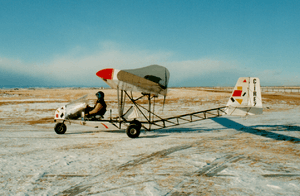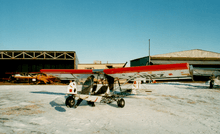Blue Yonder EZ Flyer
The Blue Yonder EZ Flyer is a Canadian-designed-and-built, tandem two-seat, open cockpit, pusher configuration, recreational and training aircraft provided as a completed aircraft or in kit form by Blue Yonder Aviation.[1][2][3][4][5]
| EZ Flyer | |
|---|---|
 | |
| Role | Kit plane |
| National origin | Canada |
| Manufacturer | Blue Yonder Aviation |
| Designer | Wayne Winters |
| First flight | October 1991 |
| Introduction | October 1991 |
| Primary user | Flight schools Private owners |
| Number built | 64 (2011) |
| Developed from | Merlin |
| Variants | Twin Engine EZ Flyer |



It can be constructed in Canada as a basic ultra-light, an advanced ultra-light or amateur-built aircraft.[1]
Development
The EZ Flyer was the first aircraft design of Wayne Winters of Indus, Alberta. In 1991 Winters set out to design a high performance kit plane that he intended to produce commercially. While considering the design parameters of that proposed aircraft he saw a picture of a Breezy homebuilt and decided instead to design a smaller and lighter aircraft inspired by the Breezy instead. Winter's own past experience flying Ultraflight Lazairs provided the motivation for the design of a slow, easy to handle aircraft with an open cockpit.[1]
Winters designed a new open lattice, "N" girder fuselage constructed from 4130 steel tube along with a new tail to be fitted with wings from the Merlin EZ. The aircraft retained the Junker's ailerons of the Merlin along with the Clark "Y" airfoil that produces docile handling characteristics. The wing also features the Merlin's leading edge "D" cell construction, with foam ribs. The prototype has two seats in tandem and is powered by a Rotax 503 two stroke engine of 50 hp (37 kW).[1][3][6][7][8]
The first prototype of the new design flew in October 1991 and was initially unnamed. Winters allowed several pilots to fly the new design and all remarked on its docile handling, its suitability as a trainer and the ease with which pilots mastered it. As a result, Winters initially named it Easy Flyer and later EZ Flyer (pronounced in the American way as "Eezee Flier").[1][3]
The EZ Flyer can be equipped with a variety of powerplants, all mounted in pusher configuration:[5][9]
- Rotax 503 50 hp (37 kW)
- Rotax 582 64 hp (48 kW)
- Rotax 912 80 hp (60 kW)
- Rotax 912S 100 hp (75 kW)
Operational history
The prototype proved robust and easy for students to learn to fly on and has been used since new as a trainer at the Blue Yonder Ultralight Flight School. By May 2001 the prototype had 2500 hours accumulated in student training and showed little signs of wear. Over 30 aircraft have been built for private owners and other flight schools.[1]
In November 2016 there were eight EZ Flyers registered in Canada and eight in the USA.[10][11]
Operators
- Blue Yonder Aviation – flight school
Specifications (Rotax 582)
Data from Blue Yonder website[2]
General characteristics
- Crew: one
- Capacity: one passenger
- Length: 21 ft (6.4 m)
- Wingspan: 31 ft (9.5 m)
- Height: 7 ft (2.1 m)
- Wing area: 176 sq ft (16.4 sq m)
- Airfoil: Clark Y[6]
- Empty weight: 495 lb (224 kg)
- Useful load: 705 lb (320 kg)
- Loaded weight: 1200 lb (544 kg)
- Powerplant: 1 × Rotax 582 fixed pitch, 64 hp (48 kW)50 hp 37 kW
- Propellers: 1 propeller, 1 per engine
Performance
- Maximum speed: 100 mph (162 km/h)
- Cruise speed: 70 mph (113 km/h)
- Stall speed: 38 mph (62 km/h)
- Range: 380 sm (615 km)
- Service ceiling: 12,000 ft (3660 m)
- Power/mass: 18.75 lb/hp (0.09 kW/kg)
Avionics
- none
See also
Aircraft of comparable role, configuration and era
References
- Hunt, Adam: Pilot Report: EZ Flyer, COPA Flight publication, page C-1, May 2001
- Winters, Wayne (n.d.). "EZ Flyer". Archived from the original on 2007-09-12. Retrieved 2009-02-28.
- Cliche, Andre: Ultralight Aircraft Shopper's Guide 8th Edition, page B-19. Cybair Limited Publishing, 2001. ISBN 0-9680628-1-4
- Vandermeullen, Richard: 2011 Kit Aircraft Buyer's Guide, Kitplanes, Volume 28, Number 12, December 2011, page 46. Belvoir Publications. ISSN 0891-1851
- Purdy, Don: AeroCrafter - Homebuilt Aircraft Sourcebook, Fifth Edition, pages 97 and 127. BAI Communications, 15 July 1998. ISBN 0-9636409-4-1
- Lednicer, David (October 2007). "The Incomplete Guide to Airfoil Usage". Archived from the original on 2008-05-15. Retrieved 2009-02-28.
- Pond, Wally (July 1995). "Flying the E-Z Flyer". Archived from the original on 2008-11-19. Retrieved 2009-02-28.
- Campbell, Jim (October 1995). "Back to basics". Archived from the original on 2008-11-19. Retrieved 2009-02-28.
- Winters, Wayne (n.d.). "Complete Kits". Archived from the original on 2009-02-14. Retrieved 2009-02-28.
- Transport Canada (7 November 2016). "Canadian Civil Aircraft Register". Retrieved 7 November 2016.
- Federal Aviation Administration (7 November 2016). "FAA Registry Make / Model Inquiry Results". Retrieved 7 November 2016.